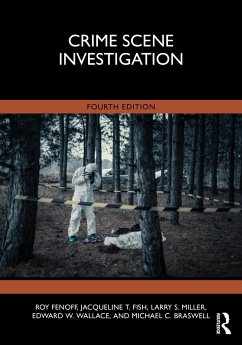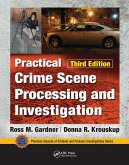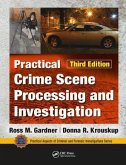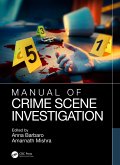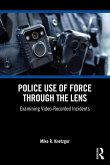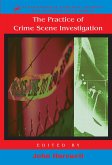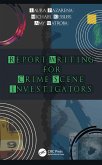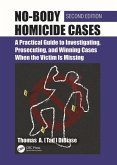- Broschiertes Buch
- Merkliste
- Auf die Merkliste
- Bewerten Bewerten
- Teilen
- Produkt teilen
- Produkterinnerung
- Produkterinnerung
Crime Scene Investigation offers an innovative approach to learning about crime scene investigation, taking the reader from the first response on the crime scene to documenting crime scene evidence and preparing evidence for courtroom presentation.
Andere Kunden interessierten sich auch für
![Practical Crime Scene Processing and Investigation, Third Edition Practical Crime Scene Processing and Investigation, Third Edition]() Ross M. Gardner (former felony criminal investigator at the U.S. ArPractical Crime Scene Processing and Investigation, Third Edition94,99 €
Ross M. Gardner (former felony criminal investigator at the U.S. ArPractical Crime Scene Processing and Investigation, Third Edition94,99 €![Practical Crime Scene Processing and Investigation, Third Edition Practical Crime Scene Processing and Investigation, Third Edition]() Ross M. Gardner (former felony criminal investigator at the U.S. ArPractical Crime Scene Processing and Investigation, Third Edition142,99 €
Ross M. Gardner (former felony criminal investigator at the U.S. ArPractical Crime Scene Processing and Investigation, Third Edition142,99 €![Manual of Crime Scene Investigation Manual of Crime Scene Investigation]() Manual of Crime Scene Investigation105,99 €
Manual of Crime Scene Investigation105,99 €![Police Use of Force Through the Lens Police Use of Force Through the Lens]() Mike R. KnetzgerPolice Use of Force Through the Lens58,99 €
Mike R. KnetzgerPolice Use of Force Through the Lens58,99 €![The Practice Of Crime Scene Investigation The Practice Of Crime Scene Investigation]() John Horswell (ed.)The Practice Of Crime Scene Investigation241,99 €
John Horswell (ed.)The Practice Of Crime Scene Investigation241,99 €![Report Writing for Crime Scene Investigators Report Writing for Crime Scene Investigators]() Laura PazarenaReport Writing for Crime Scene Investigators81,99 €
Laura PazarenaReport Writing for Crime Scene Investigators81,99 €![No-Body Homicide Cases No-Body Homicide Cases]() Thomas A. DiBiase (Tad) (The No Body Guy. Washington, D.C., USA)No-Body Homicide Cases93,99 €
Thomas A. DiBiase (Tad) (The No Body Guy. Washington, D.C., USA)No-Body Homicide Cases93,99 €-
-
-
Crime Scene Investigation offers an innovative approach to learning about crime scene investigation, taking the reader from the first response on the crime scene to documenting crime scene evidence and preparing evidence for courtroom presentation.
Hinweis: Dieser Artikel kann nur an eine deutsche Lieferadresse ausgeliefert werden.
Hinweis: Dieser Artikel kann nur an eine deutsche Lieferadresse ausgeliefert werden.
Produktdetails
- Produktdetails
- Verlag: Taylor & Francis Ltd
- 4 ed
- Seitenzahl: 442
- Erscheinungstermin: 26. Dezember 2022
- Englisch
- Abmessung: 177mm x 253mm x 31mm
- Gewicht: 1072g
- ISBN-13: 9780367204679
- ISBN-10: 0367204673
- Artikelnr.: 65609161
- Herstellerkennzeichnung
- Libri GmbH
- Europaallee 1
- 36244 Bad Hersfeld
- gpsr@libri.de
- Verlag: Taylor & Francis Ltd
- 4 ed
- Seitenzahl: 442
- Erscheinungstermin: 26. Dezember 2022
- Englisch
- Abmessung: 177mm x 253mm x 31mm
- Gewicht: 1072g
- ISBN-13: 9780367204679
- ISBN-10: 0367204673
- Artikelnr.: 65609161
- Herstellerkennzeichnung
- Libri GmbH
- Europaallee 1
- 36244 Bad Hersfeld
- gpsr@libri.de
Roy Fenoff is an Associate Professor in the Department of Criminal Justice at The Military College of South Carolina (The Citadel). He is also a Forensic Document Examiner and an expert in forgery detection. Dr. Fenoff provides scientific advice, offers training, and conducts forensic examinations for individuals, law enforcement, and law firms throughout the United States and abroad. He earned a B.S. in Entomology and a B.A. in Criminal Justice from the University of Georgia in 2004, an M.S. in Medical/Veterinary Entomology from the University of Wyoming in 2007, and a Ph.D. in Criminal Justice from Michigan State University in 2015. Dr. Fenoff specializes in forgery and document fraud, food protection (food fraud and food defense), and transnational crime. Dr. Fenoff is a published author who has presented his work at a variety of criminal justice, food safety, and forensic science conferences. In addition to his current position at The Citadel, Dr. Fenoff is a voting member of the Forensic Document Examination Consensus Body of the American Academy of Forensic Sciences Standards Board, a member of the Document Security Alliance, the South Carolina Food Safety Task Force, and a research collaborator with the Food Fraud Prevention Academy (formally Michigan State University's Food Fraud Initiative). Jacqueline T. Fish is the Vice President for Academic Affairs at Charleston Southern University. A former crime scene investigator and Lieutenant in the Knox County, Tennessee, Sherriff's Department, Dr. Fish was also project manager of the National Forensic Academy and worked with the Louisiana State University's National Center for Biomedical Research and Training to develop Advanced Forensics Investigations for Hazardous Environments. Larry S. Miller is Distinguished Professor and Chair of Criminal Justice and Criminology at East Tennessee State University (ETSU). He received his Bachelor of Science from ETSU, Master of Science from Eastern Kentucky University, and Ph.D. in Health & Safety with collaterals in Forensic Anthropology and Criminology from The University of Tennessee. Miller, who has worked as a police officer, criminal investigator, and crime laboratory director, teaches in the area of law enforcement and is the author of several books on topics including criminal investigation, criminal justice report writing, police photography, and more. Edward W. Wallace is the Director of Forensic Training at the New York City Office of Chief Medical Examiner. Wallace is also a Senior Adjunct Instructor and WMD Training Course Developer for Louisiana State University. Michael C. Braswell is Professor Emeritus of Criminal Justice and Criminology at East Tennessee State University (ETSU). Braswell received his Bachelor of Arts in Psychology from Mercer University in 1969, Master of Arts in Psychology from West Georgia College in 1970, Ed.S. in Rehabilitation/Correctional Counseling from the University of Georgia in 1973, and Doctorate in Counseling Psychology from the University of Southern Mississippi. A former prison psychologist, he taught ethics and human relations courses for more than 30 years at East Tennessee State University. He has published books on ethics, peacemaking, and correctional counseling as well as two novels and a short story collection.
Chapter 1. Introduction: The CSI and Forensic Investigation Chapter 2. The
First Response and Scene Search Chapter 3. Documenting the Crime Scene:
Photography, Videography, and Sketching Chapter 4. Fingerprints and
Palmprints Chapter 5. Trace and Impression Evidence Chapter 6. Bodily Fluid
Evidence Chapter 7. Blood Spatter Evidence Chapter 8. Firearms and Toolmark
Evidence Chapter 9. Arson and Explosives Chapter 10. The Electronic Crime
Scene Chapter 11. Documentary Evidence Chapter 12. Motor Vehicles as Crime
Scenes Chapter 13. Death Investigation Chapter 14. Forensic Anthropology,
Odontology, and Entomology Chapter 15. Documenting the Actions of the CSI
and Presenting Facts in Court, Crime Scene Supply Checklist, Glossary
First Response and Scene Search Chapter 3. Documenting the Crime Scene:
Photography, Videography, and Sketching Chapter 4. Fingerprints and
Palmprints Chapter 5. Trace and Impression Evidence Chapter 6. Bodily Fluid
Evidence Chapter 7. Blood Spatter Evidence Chapter 8. Firearms and Toolmark
Evidence Chapter 9. Arson and Explosives Chapter 10. The Electronic Crime
Scene Chapter 11. Documentary Evidence Chapter 12. Motor Vehicles as Crime
Scenes Chapter 13. Death Investigation Chapter 14. Forensic Anthropology,
Odontology, and Entomology Chapter 15. Documenting the Actions of the CSI
and Presenting Facts in Court, Crime Scene Supply Checklist, Glossary
Chapter 1. Introduction: The CSI and Forensic Investigation Chapter 2. The
First Response and Scene Search Chapter 3. Documenting the Crime Scene:
Photography, Videography, and Sketching Chapter 4. Fingerprints and
Palmprints Chapter 5. Trace and Impression Evidence Chapter 6. Bodily Fluid
Evidence Chapter 7. Blood Spatter Evidence Chapter 8. Firearms and Toolmark
Evidence Chapter 9. Arson and Explosives Chapter 10. The Electronic Crime
Scene Chapter 11. Documentary Evidence Chapter 12. Motor Vehicles as Crime
Scenes Chapter 13. Death Investigation Chapter 14. Forensic Anthropology,
Odontology, and Entomology Chapter 15. Documenting the Actions of the CSI
and Presenting Facts in Court, Crime Scene Supply Checklist, Glossary
First Response and Scene Search Chapter 3. Documenting the Crime Scene:
Photography, Videography, and Sketching Chapter 4. Fingerprints and
Palmprints Chapter 5. Trace and Impression Evidence Chapter 6. Bodily Fluid
Evidence Chapter 7. Blood Spatter Evidence Chapter 8. Firearms and Toolmark
Evidence Chapter 9. Arson and Explosives Chapter 10. The Electronic Crime
Scene Chapter 11. Documentary Evidence Chapter 12. Motor Vehicles as Crime
Scenes Chapter 13. Death Investigation Chapter 14. Forensic Anthropology,
Odontology, and Entomology Chapter 15. Documenting the Actions of the CSI
and Presenting Facts in Court, Crime Scene Supply Checklist, Glossary

